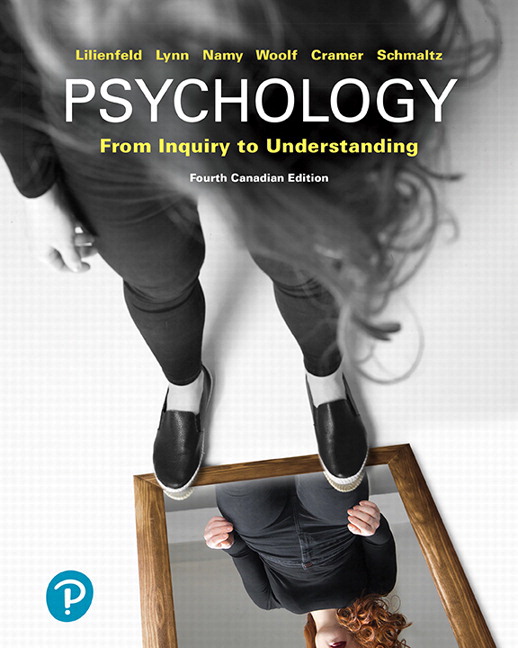Description
Psychology: From Inquiry to Understanding Canadian Edition 4th Edition Lilienfeld SOLUTION MANUAL
Solution Manual for Psychology: From Inquiry to Understanding, Canadian Edition, 4th Edition, Scott O. Lilienfeld, Steven J. Lynn, Laura L. Namy, Nancy J. Woolf, Kenneth M. Cramer, Rodney Schmaltz, ISBN-10: 0135167302, ISBN-13: 9780135167304
Table of Contents
1 Psychology and Scientific Thinking
1.1: What is Psychology? Science Versus Intuition
1.2: Psychological Pseudoscience: Imposters of Science
1.3: Scientific Thinking: Distinguishing Fact From Fiction
1.4: Psychology’s Past and Present: What a Long, Strange Trip It’s Been
2 Research Methods
2.1: The Beauty and Necessity of Good Research Design
2.2: The Scientific Method: Toolbox of Skills
2.3: Ethical Issues in Research Design
2.4: Statistics: The Language of Psychological Research
2.5: Evaluating Psychological Research
3 Biological Psychology
3.1: Nerve Cells: Communication Portals
3.2: The Brain—Behaviour Network
3.3: The Endocrine System
3.4: Mapping The Mind: The Brain in Action
3.5: Nature and Nurture: Did Your Genes – Or Your Environment – Make You Do It?
4 Sensation & Perception
4.1: Two Sides of The Coin: Sensation and Perception
4.2: Seeing: The Visual System
4.3: Hearing: The Auditory System
4.4: Smell and Taste: The Sensual Senses
4.5: Our Body Senses: Touch, Body Position, and Balance
4.6: Perception: When Our Senses Meet Our Brains
5 Consciousness
5.1: The Biology of Sleep
5.2: Dreams
5.3: Other Alterations of Consciousness and Unusual Experiences
5.4: Drugs and Consciousness
6 Learning
6.1: Classical Conditioning
6.2: Operant Conditioning
6.3: Cognitive Models of Learning
6.4: Biological Influences on Learning
6.5: Learning Fads: Do They Work?
7 Memory
7.1: How Memory Operates: The Memory Assembly Line
7.2: The Three Processes of Memory
7.3: The Biology of Memory
7.4: The Development of Memory: Acquiring A Personal History
7.5: False Memories: When Good Memory Goes Bad
8 Thinking, Reasoning, and Language
8.1: Thinking and Reasoning
8.2: Thinking at Its Hardest: Decision Making and Problem Solving
8.3: How Does Language Work?
8.4: Written Communication: Connecting Language and Reading
9 Intelligence & IQ Testing
9.1: What Is Intelligence? Definitional Confusion
9.2: Intelligence Testing: The Good, The Bad, and The Ugly
9.3: Genetic and Environmental Influences On IQ
9.4: Group Differences in IQ: The Science and the Politics
9.5: The Rest of the Story: Other Dimensions of Intellect
10 Human Development
10.1: Special Considerations in Human Development
10.2: The Developing Body: Physical and Motor Development
10.3: The Developing Mind: Cognitive Development
10.4: The Developing Personality: Social and Moral Development
11 Emotion and Motivation
11.1: Theories of Emotion: What Causes Our Feelings?
11.2: Nonverbal Expression of Emotion: The Eyes, Bodies, and Cultures Have It
11.3: Happiness: Science Confronts Popular Psychology
11.4: Motivation: Our Wants and Needs
11.5: Attraction and Love: The Greatest Mysteries of them All
12 Stress, Coping, and Health
12.1: What is Stress?
12.2: How We Adapt To Stress: Change and Challenge
12.3: Coping with Stress
12.4: How Stress Impacts Our Health
12.5: Promoting Good Health–and Less Stress!
13 Social Psychology
13.1: What Is Social Psychology?
13.2: Social Influence: Conformity and Obedience
13.3: Helping and Harming Others: Prosocial Behaviour and Aggression
13.4: Attitudes and Persuasion: Changing Minds
13.5: Prejudice and Discrimination
14 Personality
14.1: Personality: What is It and How Can We Study It?
14.2: Psychoanalytic Theory: The Controversial Legacy of Sigmund Freud and His Followers
14.3: Behavioural and Social Learning Theories of Personality
14.4: Humanistic Models of Personality: The Third Force
14.5: Trait Models of Personality: Consistencies in Our Behaviour
14.6: Personality Assessment: Measuring and Mismeasuring The Psyche
15 Psychological Disorders
15.1: Conceptions of Mental Illness: Yesterday and Today
15.2: Anxiety-Related Disorders: The Many Faces of Worry and Fear
15.3: Mood Disorders and Suicide
15.4: Personality and Dissociative Disorders: The Disrupted and Divided Self
15.5: The Enigma of Schizophrenia
15.6: Childhood Disorders: Recent Controversies
16 Psychological and Biological Treatments
16.1: Psychotherapy: Clients and Practitioners
16.2: Insight Therapies: Acquiring Understanding
16.3: Group Therapies: The More, The Merrier
16.4: Behavioural and Cognitive-Behavioural Approaches: Changing Maladaptive Actions and Thoughts
16.5: Is Psychotherapy Effective?
16.6: Biomedical Treatments: Medications, Electrical Stimulation, and Surgery





